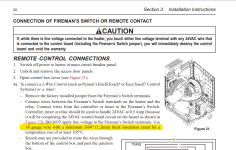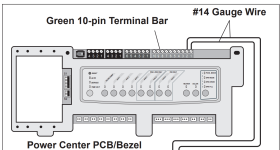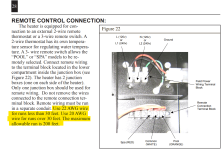So twice last year in 2023 my Jandy heater wouldn't fire up on its own even when the iAqualink app was calling for it to turn on. Both times I verified the heater itself was fine if I re-installed the wiring loop on the fireman's switch (of course, the wiring loop was long since lost, but I was able to make a new one with spade connectors).
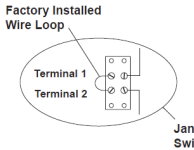
Putting that loop in place overrides any control from the Jandy iAqualink controller and instead just allows for the heater to run manually using the actual physical controls on the front of the unit. So that told me the heater itself was fine.
When this happened both times last year, I found that the voltage coming back to the fireman's switch wasn't 28VAC like it was supposed to be, it was only like 6-10VAC. My "fix" was to re-strip/re-terminate the end of the wires going to pins 1-2 of the Green 10-pin terminal bar and re-strip/re-terminate the wiring at the fireman's switch. Which seemed to get things working...
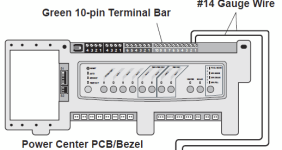
...Well fast forward to the 2024 season and I have the exact same problem so I was just going to run all NEW wiring. But this time I decided to RTFM before installing new wire because the wiring that was in place seemed very thin for 28VAC, and quickly realized the Jandy manual (on page 19) states that those wires are supposed to be 14AWG in size. The wiring that had been in place (for 12 years now?) was 22-24AWG. So this morning I replaced that older wiring with thicker gauge wiring (16AWG was all I had), but as soon as I did that, the heater started working again and I can control it from the iAqualink app once again!
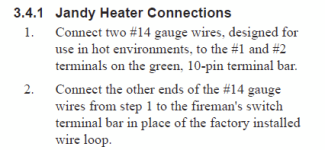
Passing along in case anyone else runs into a similar issue. (Please remember to turn off breakers for the heater and control panel BEFORE doing any re-wiring)

Putting that loop in place overrides any control from the Jandy iAqualink controller and instead just allows for the heater to run manually using the actual physical controls on the front of the unit. So that told me the heater itself was fine.
When this happened both times last year, I found that the voltage coming back to the fireman's switch wasn't 28VAC like it was supposed to be, it was only like 6-10VAC. My "fix" was to re-strip/re-terminate the end of the wires going to pins 1-2 of the Green 10-pin terminal bar and re-strip/re-terminate the wiring at the fireman's switch. Which seemed to get things working...

...Well fast forward to the 2024 season and I have the exact same problem so I was just going to run all NEW wiring. But this time I decided to RTFM before installing new wire because the wiring that was in place seemed very thin for 28VAC, and quickly realized the Jandy manual (on page 19) states that those wires are supposed to be 14AWG in size. The wiring that had been in place (for 12 years now?) was 22-24AWG. So this morning I replaced that older wiring with thicker gauge wiring (16AWG was all I had), but as soon as I did that, the heater started working again and I can control it from the iAqualink app once again!

Passing along in case anyone else runs into a similar issue. (Please remember to turn off breakers for the heater and control panel BEFORE doing any re-wiring)


